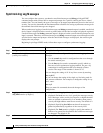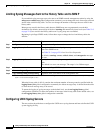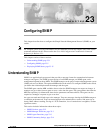
23-2
Catalyst 2950 Desktop Switch Software Configuration Guide
78-11380-05
Chapter 23 Configuring SNMP
Understanding SNMP
• Using SNMP to Access MIB Variables, page 23-4
• SNMP Notifications, page 23-5
SNMP Versions
This software release supports these SNMP versions:
• SNMPv1—The Simple Network Management Protocol, a Full Internet Standard, defined in
RFC 1157.
• SNMPv2C replaces the Party-based Administrative and Security Framework of SNMPv2Classic
with the community-string-based Administrative Framework of SNMPv2C while retaining the bulk
retrieval and improved error handling of SNMPv2Classic. It has these features:
–
SNMPv2—Version 2 of the Simple Network Management Protocol, a Draft Internet Standard,
defined in RFCs 1902 through 1907.
–
SNMPv2C—The community-string-based Administrative Framework for SNMPv2, an
Experimental Internet Protocol defined in RFC 1901.
• SNMPv3—Version 3 of the SNMP is an interoperable standards-based protocol defined in RFCs
2273 to 2275. SNMPv3 provides secure access to devices by authenticating and encrypting packets
over the network and includes these security features:
–
Message integrity—ensuring that a packet was not tampered with in transit
–
Authentication—determining that the message is from a valid source
Both SNMPv1 and SNMPv2C use a community-based form of security. The community of managers
able to access the agent’s MIB is defined by an IP address access control list and password.
SNMPv2C includes a bulk retrieval mechanism and more detailed error message reporting to
management stations. The bulk retrieval mechanism retrieves tables and large quantities of information,
minimizing the number of round-trips required. The SNMPv2C improved error-handling includes
expanded error codes that distinguish different kinds of error conditions; these conditions are reported
through a single error code in SNMPv1. Error return codes in SNMPv2C report the error type.
SNMPv3 provides for both security models and security levels. A security model is an authentication
strategy set up for a user and the group within which the user resides. A security level is the permitted
level of security within a security model. A combination of the security level and the security model
determine which security mechanism is used when handling an SNMP packet. Available security models
are SNMPv1, SNMPv2C, and SNMPv3.
Table 23-1 identifies the characteristics of the different combinations of security models and levels.
Table 23-1 SNMP Security Models and Levels
Model Level Authentication Encryption Result
SNMPv1 noAuthNoPriv Community string No Uses a community string match for authentication.
SNMPv2C noAuthNoPriv Community string No Uses a community string match for authentication.
SNMPv3 noAuthNoPriv Username No Uses a username match for authentication.
SNMPv3 authNoPriv MD5 or SHA No Provides authentication based on the HMAC-MD5
or HMAC-SHA algorithms.


















